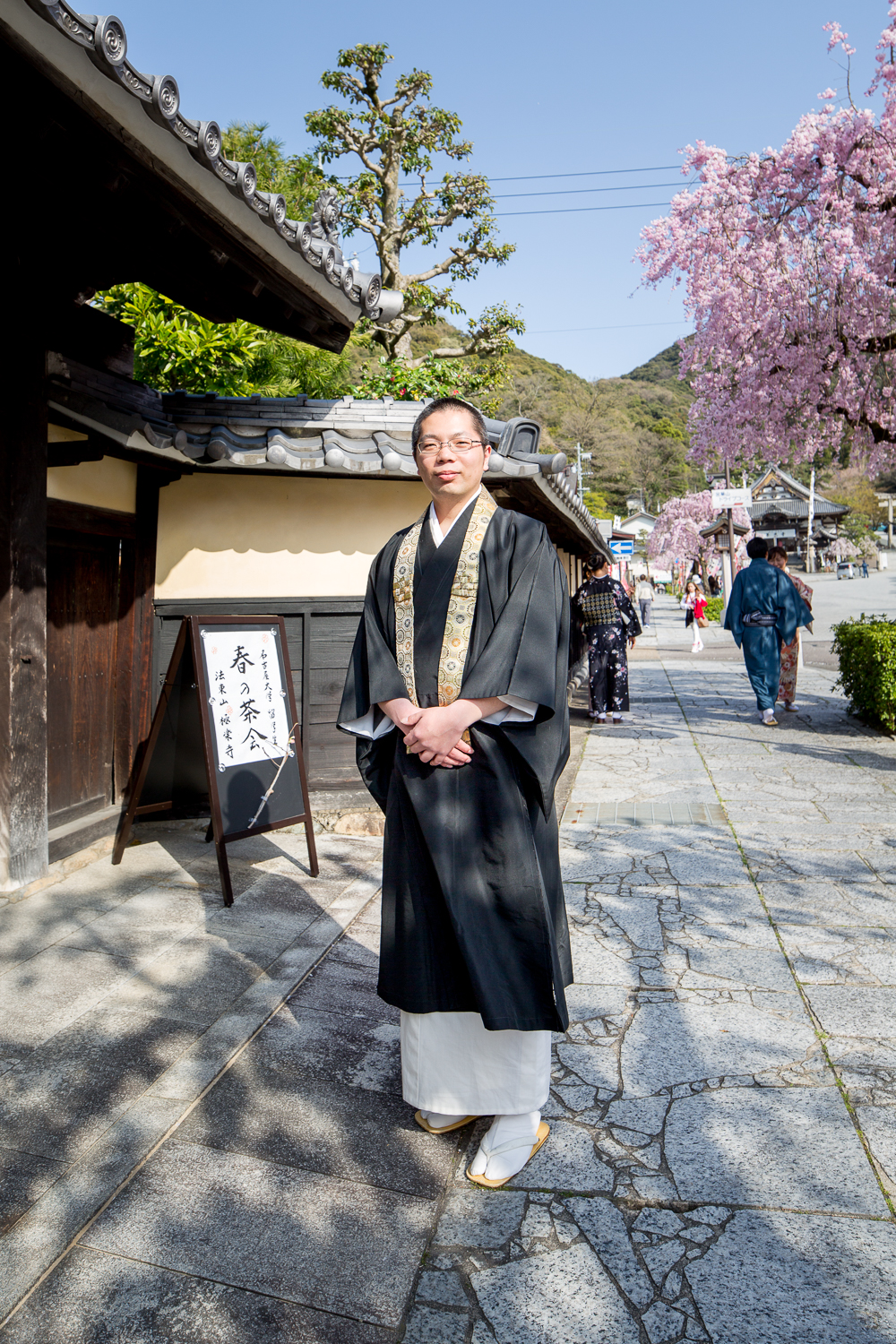
ごあいさつ -Nice to meet you!
ようこそ、法東山極楽寺のホームページをお訪ねいただき、ありがとうございます。当寺は、本山を京都永観堂禅林寺に構える浄土宗西山禅林寺派に属し、阿弥陀如来像をご本尊にいただいております。
境内には四季の花を添えつつ、昔ながらの静かなたたずまいを保っております。ご参詣いただきました折には、どうぞゆったりとした深い呼吸でお寺の気を心身に満たし、その活力を周りの方々にも分けていただきますようお願い申し上げます。
Thank you for visiting our website. This temple belongs to the school of Zyoudo-syu Sizan Zenrinji whose head temple is Eikando Zenrinji at Kyoto. Our Honzon (principal image of Buddha) is Amithaba. Gokurakuji is blessed with serene landscape and alluring seasonal flowers. The natural fresh air can soothe your inner spirit and heighten your energy. A visitor can share this energy with others who have not experienced such wonder.
1.極楽寺の歴史 -History-
斎藤道三の前の稲葉山城主であった二階堂行家は、天正12年(1584年)、当寺を岐阜県厚見郡今泉村に建立しました(田中角栄内閣の官房長官二階堂進氏は同家の子孫)。
その後、織田信長やその子孫秀信が岐阜城総構えの鎮護として各地の仏像を招致し、伊奈波神社門前に浄土宗西山派の寺院である伊奈波八ヶ寺(現在は五ヶ寺)を招致しました。
文禄・慶長年間(1592~1600年)に、当寺も、伊奈波八ヶ寺のひとつとして現在地へ移転しました。
This temple was originally built in the Imaizumi village, Atsumi county, Gifu prefecture in 1584 by the Lord of Inaba-yama Castle; Nikaido Yukiie. When Oda Nobunaga and his grandson, Hidenobu erected statues of Buddha for protection of the Gifu castle, the Inaba Eight Temples (now Five Temples) which belonged to the school of Zyoudo-syu Sinzan were relocated to the front of Inaba shrine. As one of the Inaba Eight Temples, this temple had moved to the current place.
2.お寺の役割 -Our Mission-
江戸時代において、寺請制度により国民すべてが菩提寺の檀家となることが義務づけられました。お寺は現在の戸籍にあたる宗門人別帳を作成するなど行政機関の役割を担う一方、寺子屋を運営し庶民に読み書きそろばんを教えていました。
江戸時代末期には、寺子屋のおかげでわが国の識字率が70%以上に高まりました。この識字率の高さこそが、明治維新以降の日本近代化の基礎になったと考えられています。
現在、葬式仏教といわれるようにお寺と地域が疎遠となるなか、これからのお寺の役割としては、地域に密着し、お寺とのご縁を求める方々との出会いを育み、一人ひとりの人生が豊かになることに貢献することが重要であると考えております。
During the Edo period, everyone were obliged to be followers of their family temples under the Terauke system. Temples played the role of administrative agency by making Shumon Ninbetsu Cho which is the equivalent of today’s family register. Simultaneously, they managed Terakoya (temple school) and taught literacy along with arithmetic to ordinary people. Terakoya contributed significantly to the increase of the literacy rate in Japan and had achieved a milestone of more than 70 % in the late Edo Period. Such a high literacy rate is considered to provide a basis for the modernization after the Meiji Restoration. However, contemporary Buddhism in Japan is often dubbed as “funeral Buddhism,” and as shown by this phrase, temples are alienated from local life. It is important for temples to enrich and enlighten people’s lives by maintaining good relationship with the locals and visitors of the temples.
3.住職からのメッセージ -Message-
「仏説父母恩重経(ぶっせつぶもおんじょうきょう)」というお経には、父母に対する「十の恩」が説かれています。
それは、懐胎守護(かいたいしゅご)の恩・臨生受苦(りんじょうじゅく)の恩・生子忘憂(しょうしぼうゆう)の恩・乳哺養育(にゅうほよういく)の恩・廻乾就湿(かいかんじつしつ)の恩・浅灌不浄(せんかんふじょう)の恩・嚥苦吐甘(えんくとかん)の恩・為造悪業(いぞうあくごう)の恩・遠行憶念(おんぎょうおくねん)の恩・究竟憐愍(くきょうれんみん)の恩です。
両親は、私たちが母親のお腹の中にいるときに始まり、子供の頃はもとより社会人として世に出てからも、子である私たちを心配し、想ってくれており、その死後においてもあの世から子を護りたいと願ってくれています。
では、その恩に対して、私たちはどうしたら報えるでしょうか。
ただ、親孝行すればいい、供養すればいいというわけではありません。
もちろん、親孝行、先祖供養も大切なことではありますが、その恩に報いるに十分な功徳には至りません。
布施によって、功徳を積んで下さい。「お布施」といわれると、お坊さんに渡す金銭のことをイメージされると思います。確かに布施には変わりありませんが、それは財施といい布施の中の一つに過ぎません。
布施には財施(ざいせ)・法施(ほうせ)・無畏施(むいせ)、そして無財の七施があります。日常生活の中で最も実践し易いのが無財の七施です。
無財の七施には、眼施(がんせ)・和顔施(わがんせ)・言辞施(ごんごせ)・身施(しんせ)・心施(しんせ)・床座施(しょうざせ)・房舎施(ぼうしゃせ)があります。
和やかな顔で他の人と接する、他の人に優しい言葉をかける。そんな些細なことでも、功徳を積むことになりえるのです。
One of the Buddhist scriptures, “Bussetsu Bumo Onjoukyou (Surta of Filial Piety)” states that there are ten types of kindnesses from the mother and father to the child. This statement is considered to be a life philosophy.
The ten types of kindnesses are
1) the kindness of providing protection and care while the child is in the womb
2) the kindness of bearing pain during the birth
3) the kindness of forgetting all the pain once the child has been born,
4) the kindness of breastfeeding, nourishing and raising the child,
5) the kindness of moving the child to a dry place and lying in the wet herself
6) the kindness of washing away the unclean
7) the kindness of eating the bitter herself and saving the sweet for the child
8) the kindness of deep care and devotion
9) the kindness of always thinking of the child when the child is far away
10) the kindness of ultimate pity and sympathy.
Your parents look after you while you are in the mother’s womb, infancy, childhood and adulthood. Even after death, they still wish to protect you from heaven. We must be grateful of their actions and generosity. Practicing filial piety and hold memorial services for them does not suffice for their kindnesses.
We should strive for virtue by “Fuse (alms).” When you hear “Fuse,” you may think of donating money to monks. This is known as “Zaise,” one of the many kinds of “Fuse”. In addition to “Zaise,” there are “House,” “Muise” and “Muzai no Shichise.” Among them, the easiest one to practice in daily life is “Muzai no Shichise.” It consists of seven deeds that guide our daily lives.
These deeds are
1) dealing with people with gentle eyes
2) dealing with people with a calm expression on your face
3) using attentive words
4) rendering a service by your labor,
5) being compassionate
6) giving your seat to others
7) welcoming others to your home.
These simple deeds can help you strive for virtue.
